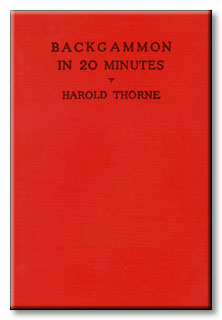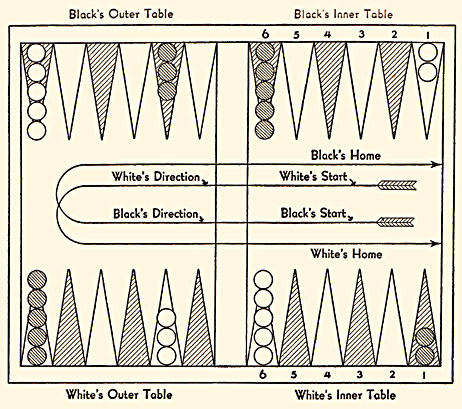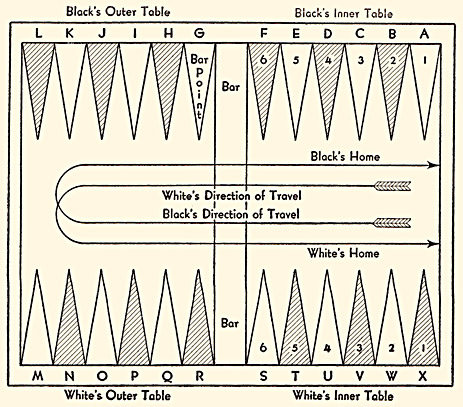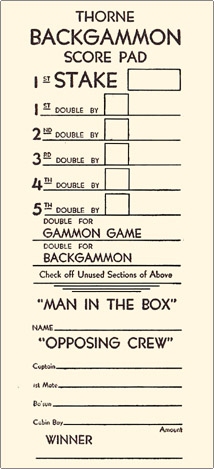|
| Book Transcription |

|

|

Backgammon in 20 Minutes
We will dismiss the history of this game by acknowledging that it is very old. The name itself actually shrieks of age.
The new method of wagering is in keeping with the rapid pace of present-day life and has greatly added to the popularity of the game. Otherwise, the game is the same as our ancestors played.
Opening the Game
The game is played by two or more players.
Fifteen checker or draughts men, and a brace of dice are used by each side on a specially constructed board.
The men are set up in certain specified positions and the object of the game is to advance the men around the board in accordance with the numbers thrown by the dice, until they have all been assembled in the home section (inner table) from which they may be worked off the board. The side first removing all its men, wins the game.
In the meantime, the opposing side is trying to achieve the same result by travelling in the opposite direction.
On the board are twenty-four points upon which men of both sides may be placed; but men of both sides cannot occupy the same point at the same time.
Any lone man on a point can be pounced upon by the enemy and sent back to start anew. (Such a man is termed a Blot.)
Two or more men on the same point cannot be disturbed by the enemy.
Except in Bearing (removing men in the final stage of the game), no moves can be made by either side unless all its men are on the board. Men sent back must be entered on the board as quickly as possible; hence, the advisability of the opponent safely occupying as many points as possible in the entry table, thereby preventing the man on the Bar from entering, as such man can be entered only by being placed on an unoccupied point.
The board is laid out in four sections called tables.

The men are set up as shown in the illustration above and White’s men have to work their way from Black’s inner table through Black’s outer table, White’s outer table, and into White’s inner table; from there, when they are all accumulated in that section, they can be removed from the board as the numbers are shaken.
The players shake the dice in turn and can move men from point to point only according to the numbers shown on the upper face of the dice.
The men can be placed on any points not occupied by two or more of the enemy. One man may be moved for the two numbers shaken, or two men may be moved. When possible, the entire numbers shaken must be taken. When doublets are thrown, you are allowed to double the doublets; that is, a throw of double threes allows you to make four moves of three points. But all numbers have to be taken separately; they cannot be totaled, though they can all be taken by one man.
Men sent back are placed on the bar and have to be entered anew in the adversary’s inner table. No moves can be made by either player having a man on the bar. You can readily see that you must avoid leaving men unprotected as much as possible. When you have to leave a blot, it is better to leave it at such a distance that it will require the total of both dice to reach the point. Failing this, it is advisable to be as close to the enemy as you can get. Ones and twos are not so easily arrived at as threes, fours, fives and sixes, because these latter numbers may be made by combining the two numbers thrown.1
No attempt can be made here to advise the player regarding the exact moves to make.
The first shake of the dice has been taken care of in the table following; but after that the matter is in the hands of the student with the advice to make as few blots as possible, in places where they are least liable to be hit; also, to cover the five-point in your inner table as quickly as possible. The next most important point is the Bar Point in the outer table — that is, the point next the bar. The next point should be the three-point. Avoid, in the early part of the game, getting your men on the low points in your inner table, as such men are practically out of the game and their use for attack greatly limited.
There are two ways of playing the game: one being to rush the men along; and the other to hold back as much as possible when you see that the opponent is getting better luck with the dice.
In playing this back game you must make as many points as possible in the opponent’s inner table and at the same time cover as many points as you can in your own inner table.
Bearing
(Moving Your Own Men From the Board)
Having all the men in the inner table, you can proceed to remove them from the board.
The reader will note that in the illustrations given in this book each point in the inner tables has been numbered. The men may be lifted from the board in accordance with the numbers thrown. For each six thrown, a man can be taken off the table from the six-point. If there should not be a man on the six-point, a man can be taken from the next point for the six-throw, and so on.
If any of opponent’s men are on the bar, you must be careful to avoid leaving a blot. It is far better to move a man to a lower point than to leave the man unprotected.
Example — Player has two men on the six-point and throws a 6-2. Opponent has a man on the bar. Player removes one man from the six-point and the remaining six-point man is moved to the four-point. On the next throw, a 6-4, one man is taken from the five-point (for the six) and another man is taken from the four-point.
Playing
For the purpose of illustrating the best method of playing the first throw of the dice, the board below has been marked with the letters of the alphabet.

White’s play. The dice show:
| Double sixes (6-6) | Move 2 men from A to G, and 2 from L to R |
| 6-5 | Move 1 man from A to L |
| 6-4 | Move 1 man from A to K, or S to W, and another from Q to W (poor) |
| 6-3 | Move 1 man from A to J |
| 6-2 | Move 1 man from L to T, or from A to I |
| 6-1 | Move 1 man from L to R, and one from Q to R |
| 5-5 | Move 2 men from L to V |
| 5-4 (poor) | Move 1 man from A to J |
| 5-3 | Move 1 man from Q to V, and one from S to V |
| 5-2 | Move 1 man from L to Q, and one from L to N |
| 5-1 | Move 1 man from L to Q, and one from S to T |
| 4-4 | Move 2 men from L to T |
| 4-3 (poor) | Move 1 man from L to P, and one from Q to T |
| 4-2 | Move 1 man fromm Q to U, and one from S to U |
| 4-1 | Move 1 man from L to P, and one from S to T |
| 3-3 | Move 2 men from Q to T, and two from S to V |
| 3-2 | Move 1 man from L to N, and one from Q to T |
| 3-1 | Move 1 man from Q to T, and one from S to T |
| 2-2 | Move 2 men from L to N, and two from S to U |
| 2-1 | Move 1 man from L to N, and one from S to T |
| 1-1 | Move 2 men from Q to R, and two from S to T |
Doubling
This doubing feature is a marked improvement and increases the thrill; a factor which is vital these days.
The rule is:
Either player may at any time, before shaking the dice, propose doubling the stakes. Opponent must accept or reject the double. If rejected, the game is ended and all wagers must be paid. However, if the proposed double is accepted, the game proceeds, and at any time before shaking the dice, the acceptor can in turn propose doubling and the original doubler must accept or reject. There is no limit to the number of times the stakes may be doubled; but after the first double the doubling must be proposed alternately.
These doubles are usually marked by placing a match on the bar.
Scoring
The player first removing all his men from the board wins the game. It is a single game if opponent has started bearing; a double game (gammon) if adversary has not removed a man (score is doubled); a triple game if adversary has a man in the winner’s inner table or on the bar (score is tripled). These doubles are in addition to those made during the play.
Example — Black has just made game; there were three doubles made during the play and opponent has a man in Black’s inner table. The original stake was for five points, which, when doubled three times makes forty points multiplied by three for the triple game, makes a total of 120 points.
Another method of scoring is known as the Philadelphia method wherein
- One point is scored for each man in the loser’s inner table
- Two points are scored for each man in the loser’s outer table
- Three points are scored for each man in the winner’s outer table
- Four points are scored for each man in the winner’s inner table
Only doubles made in play are counted in this method.

Laws
At the present moment there are no official laws, but I fear that this omission will be rectified all too soon. Let us hope that the makers will bear in mind that the game is for fun and that an accidental error, if corrected, should not be penalized.
My suggestions are:
- Each side shall roll one of the dice and the side throwing the highest number shall have choice of color and position, as well as first play, using the number thrown and number on opponent’s die. In the case of a tie, the throw shall be void and the dice thrown again.
(Reason: There may be considerable advantage to the first player if doublets are thrown, and this method of deciding who shall play first, eliminates the doublets on the first throw.)
- A player shall not be compelled to play the first man touched; however, should a second man be touched, it must be played if possible.
(Reason: There must be a limit to the number of men which can be touched without being played.)
- In no case can either number thrown by a die be waived if it can possibly be played.
- Players must throw the dice in the right-hand table, and the dice must come firmly to rest in that table. If a die becomes tilted in any way, or jump off the right-hand table, the throw is void and the dice must be shaken again.
- A play is completed when the moves required in accordance with the throw of the dice have been made and the piece or pieces quitted.
- The player next in turn shall not throw his dice until the adversary has completed the play.
- All errors in moving the pieces must be adjusted before the next throw; otherwise the errors stand.
- The player first removing all his men wins the game. Unless special provision were made previously to the first shake, all doubles shall stand as provided for in paragraph 9.
-
- After the first throw, either player may, before throwing his dice, propose doubling the stakes. If opponent rejects the proposal, the game is declared forfeit to the proposer. On the other hand, if the double is accepted, the acceptor can in turn, at any time before throwing the dice, propose the stakes be again doubled, and the original doubler must in turn accept or reject the proposal. There is no limit to the number of times the stakes may be doubled, provided it be proposed alternately by each side. The first double cannot be made when both sides are bearing, but a redouble can be proposed at any time.
- The stakes are automatically doubled if the loser has not removed one of his men, or
- The stakes are automatically tripled if the loser has a man in the winner’s inner table or on the bar.
The double in (b) or the triple in (c) are in addition to the doubles in (a).
- After the first throw, either player may, before throwing his dice, propose doubling the stakes. If opponent rejects the proposal, the game is declared forfeit to the proposer. On the other hand, if the double is accepted, the acceptor can in turn, at any time before throwing the dice, propose the stakes be again doubled, and the original doubler must in turn accept or reject the proposal. There is no limit to the number of times the stakes may be doubled, provided it be proposed alternately by each side. The first double cannot be made when both sides are bearing, but a redouble can be proposed at any time.
Chouette
A new feature, which has greatly increased the interest in Backgammon, is Chouette.
It permits more than two players to play.
Each person throws a die, and the highest number thrown indicates “the man in the box,” who plays against all the others. The second highest number thrown elects the Captain of the opposing side, and the remaining members hold seniority according to the numbers thrown.
The team may consult as to plays and doubling, and anyone of the team may elect to refuse the double proposed by “the man in the box”; in which case the rejector must pay his loss up to the time of the double, and the Captain of the team takes over his position.
“The man in the box” remains there until defeated, and then takes a position at the foot of the team that opposed him.
The Captain of the team defeating “the man in the box” then takes that position and plays against the team. Meanwhile, the second in command of the team now becomes the Captain.
Should “the man in the box” win, the Captain of the team takes the junior position and the second in command takes charge.

Reduced Facsimile of Backgammon Score Card

Pads may be obtained at book stores and stationers. Price is 25 cents.